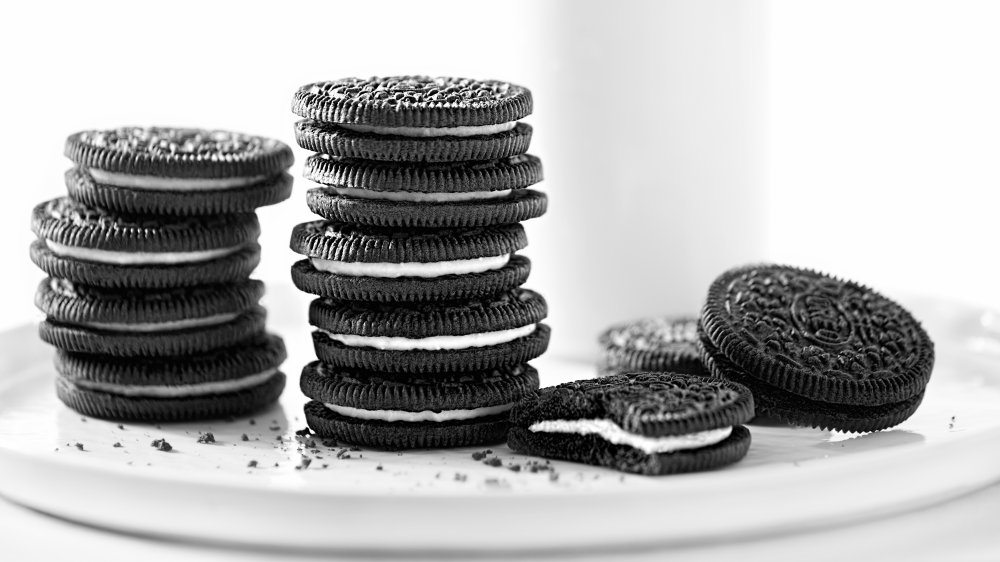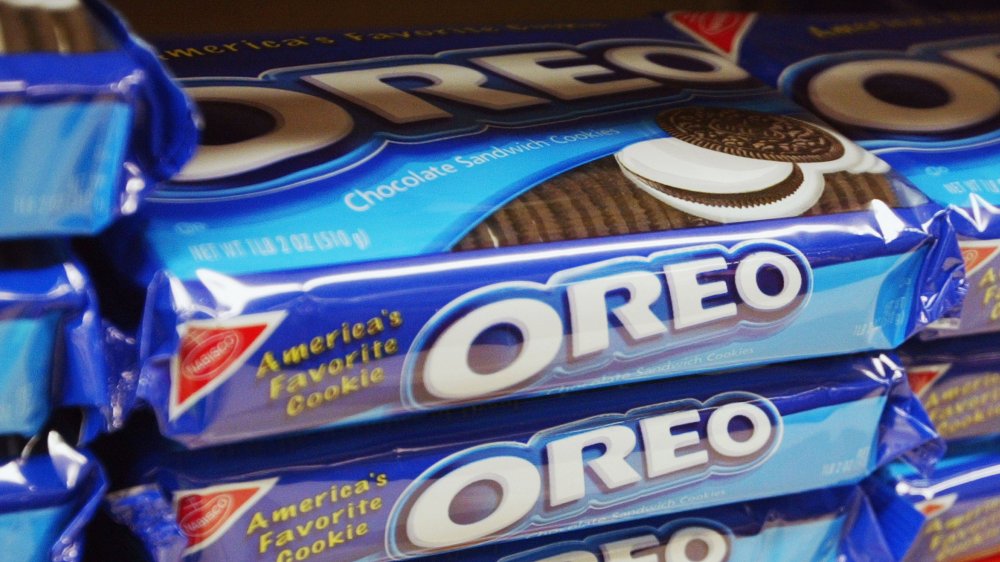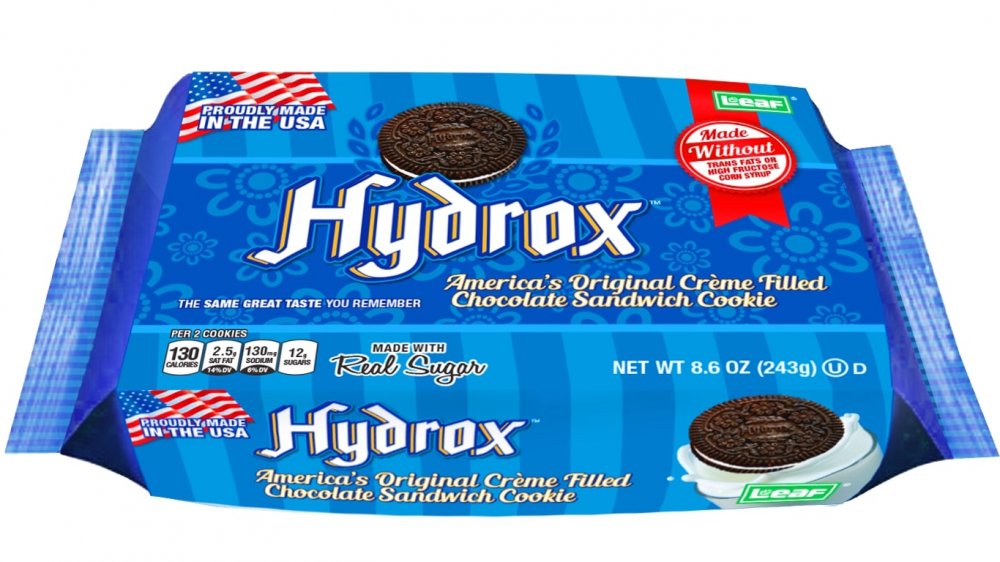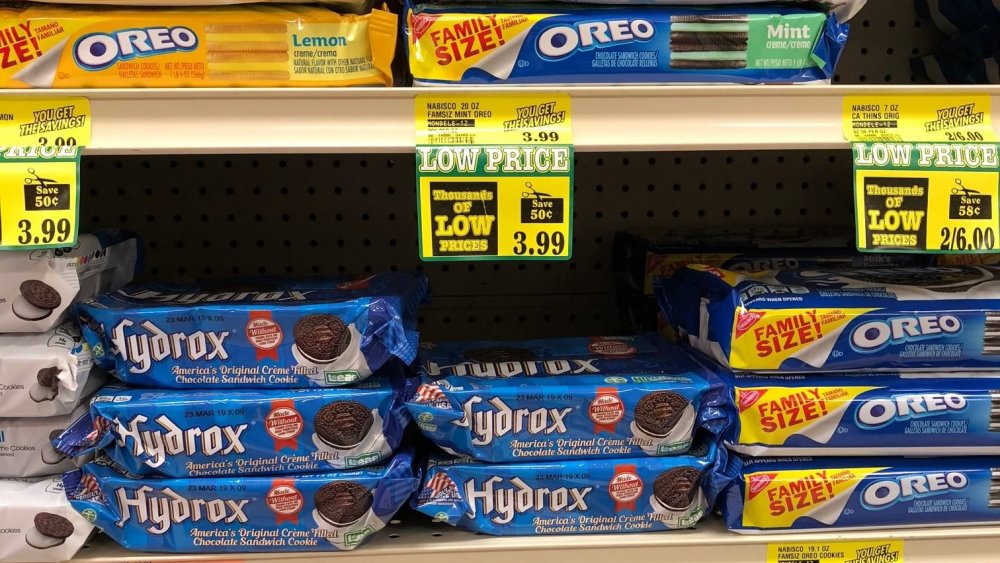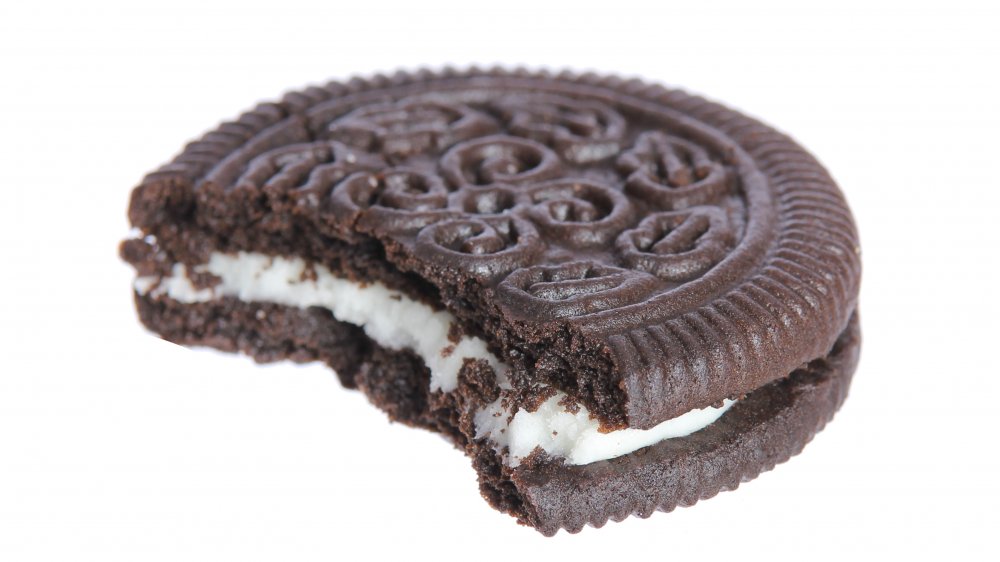The Strange History Of The Oreo And Hydrox Cookie Rivalry
Cream-filled and chocolatey, Oreo cookies have long reigned supreme as the go-to sandwich cookie on supermarket shelves, but they've become much more than that — they're a bona fide American icon. By 2017, with more than 40 billion Oreos produced every year, raking in more than $2 billion annually, they were hailed as "the best-selling cookie brand of the 21st century" by its manufacturers, Mondelez International.
So it might surprise some fans that Oreos were once considered copycats. Though they were created more than 100 years ago, in 1912, they were actually the second of its kind to hit the market. The original was launched by a company called Sunshine Biscuits in 1908 — unfortunately named Hydrox, a misplaced mashup of hydrogen and oxygen, which was supposed to suggest "purity of product" (via Atlas Obscura).
Aside from the general concept (dark chocolaty cookies sandwiching a cream center), the Hydrox cookie also sported a floral-type pattern, but when Oreos hit the scene to compete, it was the original that would eventually become the underdog — one writer for The New York Times dubbed Hydrox "the Pepsi to the Oreo's Coca-Cola."
Oreos overtake Hydrox in popularity
According to Insider, Oreos were introduced by the National Biscuit Company (later Nabisco), as "highest class biscuits." But they did not immediately overtake Hydrox. That process took decades, as the two competing manufacturers engaged in "biscuit wars," with Hydrox warning customers of "imposters" and Nabisco execs stubborn enough to absorb losses on the then-unsuccessful Oreo (via Serious Eats). But, with a redesign and aggressive ad campaign (plus a price hike), sales turned around for Oreos in the mid-1950s.
As Serious Eats explains, Sunshine soon went belly-up, and Hydrox was eventually destined for the dustbin of history — but not before being ping-ponged around to companies like American Tobacco Company, Keebler, and Kellogg's. Keebler attempted to fix the unfortunate name issue by rebranding as Droxies, but the damage was done — only two years after Kellogg's assumed ownership in 2001, Hydrox was off the market (via Atlas Obscura).
Oreos, meanwhile, stormed ahead with a slew of innovations over the years: Oreo flavors (including "mystery" ones), tie-ins with McDonald's, Double Stuf and Supreme varieties, even glitter-filled versions in 2020.
Hydrox returns to take on Oreo
In 2019, Oreos set a new net-revenue record of $3.1 billion, with 92 million cookies sold per day throughout 100-plus countries (via Mondelez International). But Hydrox, in a twist of fate, returned to wage war again — this time, teaming up with Amazon (via Digital Commerce 360). And, so far, the battle hasn't been any prettier the second time around.
Leaf Brands, which reintroduced Hydrox in 2015, throws not-so-subtle shade toward Oreos on its website, saying, "don't eat a knock-off," and pointing out that its cookies are darker chocolate and crunchier, with a less-sweet filling. The company also calls attention to using real cane sugar (Oreos contain high-fructose corn syrup), plus a "cleaner label," sans hydrogenated oils, artificial flavors, and GMOs.
In 2016, Leaf Brands even released a statement asserting that Hydrox keeps jobs in the United States via manufacturing, while Mondelez International was laying off U.S. workers in favor of moving some production to a Mexico-based plant. This was in response to President Trump criticizing the makers of Oreo for taking manufacturing outside the country, and Hydrox promptly slapped a stamp on packaging that proclaims, "Proudly made in the USA," next to the American flag.
The reintroduction appeared to pay off, with Bakeryandsnacks.com reporting that sales of Hydrox grew by 2,406 percent from 2016 to 2017, amassing more than $492,000 in sales — clearly, still light-years away from Oreo's overwhelming dominance in the market, but impressive progress nonetheless.
The Hydrox vs. Oreo rivalry heats up
Events took a particularly nasty turn between the rival cookie manufacturers when Leaf Brands filed a lawsuit against Mondelez International in August 2018, seeking $800 million in damages because of "lost sales and reputation" (via Food Business News). The charges claimed that Mondelez was using its massive industry muscle "to place their own products in favorable locations in stores and move competitors in less desirable positions on store shelves."
On the Hydrox Cookies Facebook page, images from grocery stores showed its cookies hidden behind other shelf displays, scooted to the back of shelves, and even stacked the wrong way so that only the tips of its bags were visible (via Gizmodo).
Mondelez International issued an aloof response via a spokesperson: "We have not been contacted about this, but we are confident that this accusation has no merit. The Oreo brand is an iconic one, with a proud and rich history of delivering great tasting products and exciting innovations to our consumers for more than a century. This focus, and our commitment to operating with integrity, has made Oreo America's favorite cookie."
In another bizarre twist, President Trump made a second appearance in Hydrox's history for 2020, as The Wall Street Journal proclaimed that, possibly due to President Trump's talk of hydroxychloroquine for treating COVID-19, Google searches of Hydrox cookies were soaring.
How do Oreo and Hydrox cookies differ in taste?
With so much back-and-forth bitterness behind the cookie-sandwich scenes, taste testers have been anxious to compare the two. A reviewer with Food Crumbles found they "taste very different," with the Oreo cookie described as "a little more bitter" and "less like chocolate," while the Hydrox was perceived to have a less-sweet filling and improved crunchiness (just as the makers proclaim).
In a Kotaku "showdown" between the cookies, Hydrox was applauded for a "smoother creme that's got a subtle tang and a bit less cloying sweetness ... Hydrox's creme is less spackley." For the cookies themselves, Hydrox had a "stronger chocolate scent and a more pronounced cocoa taste," with Oreo being "lighter and more prone to crumbling. It's slightly sweeter." Overall, the reviewer proclaimed that he was "completely taken aback by Hydrox's taste and quality."
However, among a test of 10 cookie brands in which the Epicurious editorial team tried to top the Oreo, Hydrox did not make the cut among the top two alternatives listed. A pair of YouTube reviewers voiced their preference for the Oreos but also enjoyed the Hydrox cookies in a blind taste test, complaining only of the latter's slight aftertaste but enjoying their "brownie-ish" flavor.
With many impassioned fans on either side of the aisle, looks like the debate — and, undoubtedly, the companies' own cookie war — may be fated to rage on for the next hundred years.
